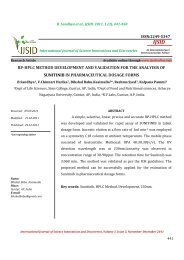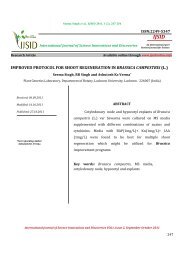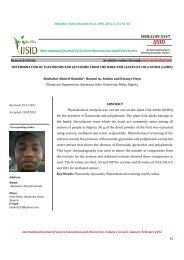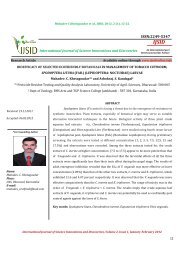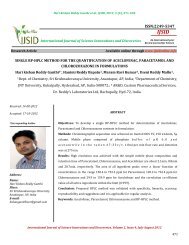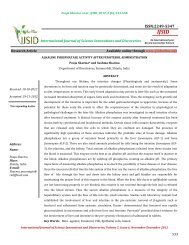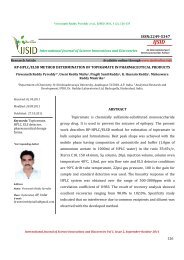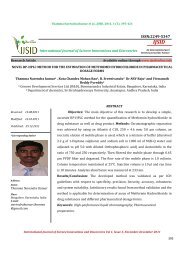drug nanocrystals: novel technique for delivery of ... - Ijsidonline.info
drug nanocrystals: novel technique for delivery of ... - Ijsidonline.info
drug nanocrystals: novel technique for delivery of ... - Ijsidonline.info
You also want an ePaper? Increase the reach of your titles
YUMPU automatically turns print PDFs into web optimized ePapers that Google loves.
Sneha V Sawant et al., IJSID 2011, 1 (3), 1-15ISSN:2249-5347IJSIDInternational Journal <strong>of</strong> Science Innovations and DiscoveriesAn International peerReview Journal <strong>for</strong> ScienceReview ArticleDRUG NANOCRYSTALS: NOVEL TECHNIQUE FOR DELIVERY OF POORLY SOLUBLE DRUGSSneha V. Sawant*, DR. Vilasrao J. Kadam, DR. Kisan R. Jadhav and Shirish V. Sankpal*Department <strong>of</strong> Pharmaceutics, Bharati Vidyapeeth's College <strong>of</strong> Pharmacy, Sector-8, CBD Belapur, Navi MumbaiReceived: 16.09.2011Modified: 03.10.2011Published: 29.12.2011Keywords:Nanocrystal,Dissolution rate,Particle size,Bioavailability,Stabilizers*Corresponding AuthorName:Sneha V SawantPlace:Navi Mumbai, Maharashtra, IndiaE-mail:manu2sneha@gmail.com400614.Available online through www.ijsidonline.<strong>info</strong>ABSTRACTDuring the last two decades, many modern technologies have beenestablished in the pharmaceutical research and development area. Theautomation <strong>of</strong> the <strong>drug</strong> discovery process by technologies such as highthroughput screening, combinatorial chemistry, and computer- aided <strong>drug</strong>design is leading to a vast number <strong>of</strong> <strong>drug</strong> candidates possessing a very goodefficacy. Un<strong>for</strong>tunately, many <strong>of</strong> these <strong>drug</strong> candidates are exhibiting pooraqueous solubility. The use <strong>of</strong> <strong>drug</strong> <strong>nanocrystals</strong> is a universal <strong>for</strong>mulationapproach to increase the therapeutic per<strong>for</strong>mance <strong>of</strong> these <strong>drug</strong>s.Nanocrystal dispersions comprise water, active <strong>drug</strong> substance and astabilizer. They are physically stable due to the presence <strong>of</strong> stabilizers thatprevent reagragregation <strong>of</strong> the active <strong>drug</strong> substance. Different <strong>technique</strong>scan be used to prepare nanocrystal <strong>for</strong>mulations <strong>of</strong> a <strong>drug</strong> powder such ashomogenization, coprecipitation, spray drying and milling. There are severalINTRODUCTIONadvantages <strong>of</strong> nanocrystal <strong>for</strong>mulations such as, enhanced oralbioavailability, improved dose proportionality, reduced food effects,suitability <strong>for</strong> administration by all routes and possibility <strong>of</strong> sterile filtrationdue to decreased particle size range. Nanocrystal technology is cheap andINTRODUCTIONeasy to apply; thus, it appears that this technology will be substantiallyuseful <strong>for</strong> the manufacture <strong>of</strong> poorly water-soluble <strong>drug</strong> products. Thisreview article describes the physicochemical properties <strong>of</strong> <strong>drug</strong><strong>nanocrystals</strong>, production methods, potential clinical applications andlimitations.International Journal <strong>of</strong> Science Innovations and Discoveries, Volume 1, Issue 3, November-Deceber 20111
Sneha V Sawant et al., IJSID 2011, 1 (3), 1-15INTRODUCTIONIt is estimated that 40% or more <strong>of</strong> active substances being identified through combinatorial screeningprograms are poorly soluble in water. Poor solubility is not only a problem <strong>for</strong> the <strong>for</strong>mulation development andclinical testing; it is also an obstacle at the very beginning when screening new compounds <strong>for</strong> pharmacologicalactivity. From this, there is a definite need <strong>for</strong> smart technological <strong>for</strong>mulation approaches to make such poorlysoluble <strong>drug</strong>s bioavailable. Making such <strong>drug</strong>s bioavailable means that they show sufficiently high absorption afteroral administration, or they can alternatively be injected intravenously. [1] Since many years the approaches toincrease <strong>drug</strong> solubility are solubilisation by surfactants, complex <strong>for</strong>mation (e. g. cyclodextrin, macromolecules)self-emulsifying <strong>drug</strong> <strong>delivery</strong> systems (SEDDS), microemulsions and especially <strong>for</strong> oral administrationmicronisation <strong>of</strong> <strong>drug</strong> powders [2] . Micronization, meaning the transfer <strong>of</strong> <strong>drug</strong> powders into the size rangebetween typically 1-10μm. However, nowadays many <strong>drug</strong>s are so poorly soluble that micronization is notsufficient. The increase in surface area, and thus consequently in dissolution velocity, is not sufficient to overcomethe bioavailability problems <strong>of</strong> very poorly soluble <strong>drug</strong>s <strong>of</strong> the biopharmaceutical specification class II. Aconsequent next step was to move from micronization to nanonization. At the beginning <strong>of</strong> the 1990s the <strong>drug</strong><strong>nanocrystals</strong> were developed as more efficient approach to increase <strong>drug</strong> solubility and dissolution velocity.Instead <strong>of</strong> micronising the <strong>drug</strong> powder, it is nanonised leading to <strong>nanocrystals</strong> with a typical size <strong>of</strong> about 200 nmup to approximately 600 nm. Drug <strong>nanocrystals</strong> can be used <strong>for</strong> a chemical stabilization <strong>of</strong> chemically labile <strong>drug</strong>s.The <strong>drug</strong> paclitaxel can be preserved from degradation when it is <strong>for</strong>mulated as a nanosuspension. [3] The sameresult was found <strong>for</strong> the chemically labile <strong>drug</strong> omeprazole when <strong>for</strong>mulated as a nanosuspension, the stability wasdistinctly increased in comparison to the aqueous solution. [4]Increasing Dissolution through NanonizationMost differentiating features <strong>of</strong> <strong>drug</strong> <strong>nanocrystals</strong> are the increased saturation solubility and theaccelerated dissolution velocity. A <strong>drug</strong> specific constant which depends only on the solvent and the temperature iscalled as the saturation solubility (Cs). As described by the Nernst Brunner/Noyes-Whitney equation [5] , the solidAPI dissolution rate is proportional to the surface area available <strong>for</strong> dissolution as discussed belowWhere, dx/dt= dissolution rate, Xd = amount dissolved, A= particle surface area, D = dissolution rate constant,V = volume <strong>of</strong> fluid available <strong>for</strong> dissolution, Cs =saturation solubility, h = effective boundary layerthickness.Hence, due to further decrease in the particle size in the sub-micron range will further increase dissolutionrate because <strong>of</strong> increase insurface area. Furthermore, as explained by the Prandtl equation, the diffusion layerthickness will also be reduced, thus resulting in an enhanced dissolution rate. [6] An increase in saturation solubility<strong>of</strong> the nanosized API has also been explained by the Freundlich–Ostwald equation:International Journal <strong>of</strong> Science Innovations and Discoveries, Volume 1, Issue 3, November-Deceber 20112
Sneha V Sawant et al., IJSID 2011, 1 (3), 1-15Where, S = saturation solubility <strong>of</strong> the nanosized API, S∞= saturation solubility <strong>of</strong> an infinitely largeAPIcrystal, = crystal-medium interfacial tension, M = molecular weight <strong>of</strong> the compound, r = particleradius,ρ = density, R = gas constant, T =temperature.Finally, surface wetting increment by surfactants in nanosuspension <strong>for</strong>mulations, in comparison toconventional micronized <strong>for</strong>mulations results in further enhancement <strong>of</strong> dissolution rates. Hence, bettertherapeutic <strong>drug</strong> efficacy was obtained. Also, the rejection <strong>of</strong> new <strong>drug</strong> entities because <strong>of</strong> poor solubility can beprevented. Hence <strong>novel</strong> and patented <strong>technique</strong>s are mushrooming up in the pharmaceutical sector. [7]Nanocrystal TechnologyPreparation <strong>of</strong> <strong>drug</strong> <strong>nanocrystals</strong> is basically a nanosizing method, which is utilized to enhance the oralbioavailability <strong>of</strong> poorly water-soluble <strong>drug</strong>s. Drug <strong>nanocrystals</strong> are nanoscopic crystals <strong>of</strong> the <strong>drug</strong> withdimensions less than 1000 nm as defined in the first patents in this field. [8] Nanocrystal dispersions containdispersion media (water, aqueous solutions or nonaqueous media), active <strong>drug</strong> substances and surface activeagents or polymers required <strong>for</strong> stabilization. [9] If necessary, other substances such as buffers, salts and sugars canbe added.There are many advantages <strong>of</strong> nanocrystal <strong>for</strong>mulations designed <strong>for</strong> oral administration. Theyare asfollows:• Increased rate <strong>of</strong> absorption• Increased oral bioavailability• Rapid effect• Improved dose proportionality• Reduction in required dose• Applicability to all routes <strong>of</strong> administration inany dosage <strong>for</strong>m. Contrary to micronized <strong>drug</strong>s, <strong>nanocrystals</strong> can beadministered via several routes. Oral administration is possible in the <strong>for</strong>m <strong>of</strong> tablets, capsules, sachets or powder;preferably in the <strong>for</strong>m <strong>of</strong> a tablet. Nanosuspensions can also be administered via the intravenous route due to verysmall particle size, and in this way, bioavailability can reach 100 %.• Reduction in fed/fasted variability• Rapid, simple and cheap <strong>for</strong>mulation development• Possibility <strong>of</strong> high amounts (30-40 %) <strong>of</strong> <strong>drug</strong> loading• Increased reliability - Usually side effects are proportional to <strong>drug</strong> concentration, so decreasing the concentration<strong>of</strong> active <strong>drug</strong> substances leads to an increased reliability <strong>for</strong> patients• Sustained crystal structure-Nanocrystal technology leads to an increase in dissolution rate depending on theincrease in surface area obtained by reduction <strong>of</strong> the particle size <strong>of</strong> the active <strong>drug</strong> substance down to the nanosize range preserving the crystal morphology <strong>of</strong> the <strong>drug</strong>•Improved stability- They are stable systems because <strong>of</strong> the use <strong>of</strong> a stabilizer that preventsInternational Journal <strong>of</strong> Science Innovations and Discoveries, Volume 1, Issue 3, November-Deceber 20113
Sneha V Sawant et al., IJSID 2011, 1 (3), 1-15reaggregation <strong>of</strong> active <strong>drug</strong> substances during preparation . Suspension <strong>of</strong> <strong>drug</strong> <strong>nanocrystals</strong> in liquid can bestabilized by adding surface active substances or polymers• Applicability to all poorly soluble <strong>drug</strong>s becauseall these <strong>drug</strong>s could be directly disintegrated into nanometersizedparticles. [10]Bottom up TechnologiesThere are two basic approaches to produce <strong>drug</strong> <strong>nanocrystals</strong>, the bottom up and the top downtechnologies. In the bottom up processes, one starts from the molecule in solution, the molecules are aggregated to<strong>for</strong>m particles, being crystalline or amorphous. There are various bottom up technologies. [11]1. Precipitation methodA poor water-soluble <strong>drug</strong> is dissolved in an organic medium, which is water miscible. A pouring <strong>of</strong> thissolution into a non solvent, such as water, will cause a precipitation <strong>of</strong> finely dispersed <strong>drug</strong> <strong>nanocrystals</strong>. Aproblem associated with this technology is that the <strong>for</strong>med nanoparticles need tobe stabilized to avoid growth inmicrometer crystals. In addition, the <strong>drug</strong> needs to be soluble at least in one solvent , this creates problems <strong>for</strong> thenewly synthesized or discovered <strong>drug</strong>s, being poorly soluble in water and simultaneously in organic media.Lyophilization is recommended to preserve the particle size. Another approach to preserve the size <strong>of</strong> theprecipitated <strong>nanocrystals</strong> is the use <strong>of</strong> polymeric growth inhibitors, which are preferably solublein the aqueousphase. The increased viscosity <strong>of</strong> the aqueous phase can reduce particle growing. [12 ] A basic disadvantage <strong>of</strong> manyprecipitation processes is the use <strong>of</strong> organic solvents, which need to be removed again in most cases, increasing thecosts. Especially when large solvent volumes are required, being the case when the <strong>drug</strong> exhibits low solubility inwater and also in organic solvents. There<strong>for</strong>e, <strong>for</strong> pharmaceutical industry, typically the top down technologies areemployed <strong>for</strong> the products introduced to the market. [13]2. SonocrystallizationRecrystallization <strong>of</strong> poorly soluble material using liquid solvents and antisolvents has also been employedsuccessfully to reduce particle size. The <strong>novel</strong> approach <strong>for</strong> particle size reduction on the basis <strong>of</strong> crystallization byusing ultrasound is sonocrystallization. Sonocrystallization utilizes ultrasound power characterized by a frequencyrange <strong>of</strong> 20-100 kHz <strong>for</strong> inducing crystallization. It not only enhances the nucleation rate but also an effectivemeans <strong>of</strong> size reduction & controlling size distribution <strong>of</strong> the active pharmaceutical ingredient (API). Mostapplications used ultrasound in the range 20 khz -5mhz.Sonocrystallization <strong>technique</strong> or technology has also beenstudied to modify the undesirables <strong>of</strong> NSAID’S I) i.e. poor solubility and dissolution rate and consequently the poorbioavailiability. Flubipr<strong>of</strong>en was poured in deionized water at 25°C and sonicated <strong>for</strong> 4 minutes at an amplituted <strong>of</strong>60% and cycle is 40 sec on and 10 sec <strong>of</strong>f. The particle size <strong>of</strong> treated flubipr<strong>of</strong>en was significantly reduced and theincreased solubility <strong>of</strong> treated flurbipr<strong>of</strong>en was about 35%. The intrinsic dissolution rate <strong>of</strong> treated flubipr<strong>of</strong>enincreased by 2-fold. The dissolution studies obtained that 90% <strong>of</strong> the <strong>drug</strong> was released within 20 minutes <strong>for</strong>treated flubipr<strong>of</strong>en as compared to untreated flubipr<strong>of</strong>en obtained 60% release <strong>of</strong> the <strong>drug</strong>.International Journal <strong>of</strong> Science Innovations and Discoveries, Volume 1, Issue 3, November-Deceber 20114
Sneha V Sawant et al., IJSID 2011, 1 (3), 1-153. Gas antisolvent recrystallization-GASThis processing requires <strong>drug</strong> polymer mixture be solubilized via conventional means into a solvent i.e.then sprayed into an SCF (supercritical fluid), the <strong>drug</strong> should be miscible with the organic solvent. The SCFdiffuses into the spray droplets, causing expansion <strong>of</strong> the solvent present and precipitation <strong>of</strong> the <strong>drug</strong> particles.The low solubility <strong>of</strong> poorly water-soluble <strong>drug</strong>s and surfactants in supercritical CO2 and the high pressurerequired <strong>for</strong> these processes restrict the utility <strong>of</strong> this technology in the pharmaceutical industry. [14]Top Down TechnologiesIn the top down technologies, one starts from large crystals in the μm range and goes down to the nanodimension by diminuting the crystals.There are several top down technologies which are discussed below. [11]1. Media millingIn this protocol, the milling chamber is charged with milling pearls, dispersion media(e.g. water), <strong>drug</strong>powders and stabilizers. The pearls are rotated at a very high speed to generate strong shear <strong>for</strong>ces to disintegrate<strong>drug</strong> powders into nanoparticles. The pearls or balls consist <strong>of</strong> ceramics, stainless steel, glass, or highly crosslinkedpolystyrene resin-coated beads. [15] Physical characteristics <strong>of</strong> the resulting <strong>nanocrystals</strong> depend on thenumber <strong>of</strong> milling pearls, the amount <strong>of</strong> <strong>drug</strong> and stabilizer, and milling time, speed and temperature. Drug<strong>nanocrystals</strong> can be prepared by a wet milling procedure using a rotation/revolution mixer and zirconia balls. The<strong>technique</strong> showed superior per<strong>for</strong>mance compared with the beads mill, enabling <strong>drug</strong> <strong>nanocrystals</strong> to be producedin a quick process (approximately 5 min) using a small amount <strong>of</strong> zirconia balls. The potential shortcomings <strong>of</strong>media milling are difficulty in the removal <strong>of</strong> residual milling media fromthe final product and the loss <strong>of</strong> <strong>drug</strong>owing to adhesion to the inner surface <strong>of</strong> the milling chamber. [16] A problem associated with the pearl millingtechnology is the erosion from the milling material during the milling process. In order to reduce the quantity <strong>of</strong>impurities caused by an erosion <strong>of</strong> the milling media, the milling beads were coated with highly cross-linkedpolystyrene resin. [17] Furthermore, the method is not suitable <strong>for</strong> <strong>drug</strong> powders with elasticity. Despite theselimitations, the milling method is the most commonly used method in industry because <strong>of</strong> its low cost and capacity<strong>for</strong> rapid production. [16]2. High Pressure Homogenization methods1. Micr<strong>of</strong>luidization (IDD-P technology)The micr<strong>of</strong>luidizer is a jet stream homogenizer <strong>of</strong> two fluid streams collided frontally with high velocity (upto1000m/sec) under pressures up to 4000 bar. There is aturbulent flow, high shear <strong>for</strong>ces, particles collied leadingto particle diminution to the nanometer range.The high pressure applied and the high streaming velocity <strong>of</strong> thelipid can also lead to cavitation additionally, contributing to size diminution. To preserve the particle size,stabilization with phospholipids or other surfactants and stabilizers is required. A major disadvantage <strong>of</strong> thisprocess is the required production time. In many cases, 50 to 100 time- consuming passes are necessary <strong>for</strong> asufficient particle size reduction. SkyePharma Canada, Inc. (previously RTP, Inc.) applies this principle <strong>for</strong> its IDD-P technology toproduce submicron particles <strong>of</strong> poorly soluble <strong>drug</strong>s. [15]International Journal <strong>of</strong> Science Innovations and Discoveries, Volume 1, Issue 3, November-Deceber 20115
Sneha V Sawant et al., IJSID 2011, 1 (3), 1-152. Piston-gap homogenizationIt is also known as High pressure homogenization in water (Dissocubes®).Drug <strong>nanocrystals</strong> can also beproduced by high-pressure homogenization using piston gap homogenizers.Depending on the homogenizationtemperature and the dispersion media, there is a difference between the Dissocubes® technology and theNanopure® technology.Dispersion medium <strong>of</strong> the suspensions was water. A piston in a large bore cylinder createspressure up to 2000bar. The suspension is pressed through a very narrow ring gap. The gap width is typically inthe range <strong>of</strong> 3-15 micrometer at pressures between 1500-150 bar. There is a high streaming velocity in the gapaccording to the Bernouli equation. Due to the reduction in diameter from the large bore cylinder (e.g. 3 cm) to thehomogenization gap, the dynamic pressure (streaming velocity) increases and simultaneously decreases the staticpressure on the liquid. The liquid starts boiling, and gas bubbles occur which subsequently implode, when thesuspension leaves the gap and is again under normal pressure (cavitation). Gas bubble <strong>for</strong>mation and implosionlead to shock waves which cause particle diminution. The patent describes cavitation as the reason <strong>for</strong> theachieved size diminution. [18] The use <strong>of</strong> water as dispersion medium is associated with some disadvantages.Hydrolysis <strong>of</strong> water-sensitive <strong>drug</strong>s can occur, as well as problems during drying steps. In cases <strong>of</strong> thermolabile<strong>drug</strong>s or <strong>drug</strong>s possessing a low melting point, a complete water removal requires relatively expensive <strong>technique</strong>s,such as lyophilization. For these reasons, the Dissocubes® technology is particularly suitable if the resultingnanosuspension is directly used without modifications, such as drying steps.Many different <strong>drug</strong>s have beenprocessed by high pressure homogenization to produce DissoCubes. Up to now each <strong>drug</strong> investigated could beconverted into a nanosuspension. Examples include RMKP22, carbamazepin, bupravaquone aphidicolin,cyclosporine, paclitaxel, RMBB98, azodicarbonamide, and prednisolone. [19]3. Nanopure® TechnologyIn Nanopure technology (PharmaSol GmbH, Germany), poorly water-soluble <strong>drug</strong>s are transferred to <strong>drug</strong><strong>nanocrystals</strong> via a high-pressure homogenization process. The <strong>drug</strong> powder is dispersed in a surfactant solutionand the <strong>for</strong>ces in the high-pressure homogenizer are strong enough to disintegrate the coarse <strong>drug</strong> powder into<strong>drug</strong> nanoparticle with a mean diameter, typically between 200–600 nm. The <strong>drug</strong> powder is dispersed in anonaqueous medium (e.g., PEG 600, Miglyol 812) or a water-reduced mixture (e.g., water-ethanol) and theobtained presuspension is homogenized in a piston-gap homogenizer. A suitable machine <strong>for</strong> the laboratory scaleis the Micron Lab 40 (APV Deutschland GmbH). Nonaqueous dispersion media such as PEG or oils yieldsuspensions that are suitable <strong>for</strong> the direct filling <strong>of</strong> capsules and thus an intermediate step required when usingpure aqueous nanosuspension is avoided. With nanopure technology, homogenization can be per<strong>for</strong>med in anonaqueous phase or phases with reduced water content. And, in contrast to more pronounced cavitation at highertemperatures, homogenization was similar or more efficient at lower temperatures, even below the freezing point<strong>of</strong> water. [20]International Journal <strong>of</strong> Science Innovations and Discoveries, Volume 1, Issue 3, November-Deceber 20116
Sneha V Sawant et al., IJSID 2011, 1 (3), 1-15COMBINATION TECHNOLOGIES1. Nanoedge® TechnologyNanoedge technology (Baxter Healthcare Corporation, Deerfield, IL) described the <strong>for</strong>mulation method <strong>for</strong>poorly water-soluble <strong>drug</strong>s. It is a useful technology <strong>for</strong> active ingredients that have high melting points and highoctanol-water partition coefficients, logP. It is based on direct homogenization, microprecipitation, and lipidemulsions. In microprecipitation, the <strong>drug</strong> first is dissolved in a water-miscible solvent to <strong>for</strong>m a solution. Then,the solution is mixed with a second solvent to <strong>for</strong>m a presuspension and energy is added to the presuspension to<strong>for</strong>m particles having an average effective particle size <strong>of</strong> 400 nm to 2 μ. The energy-addition step involves addingenergy through sonication, homogenization, countercurrent flow homogenization, micr<strong>of</strong>luidization, or othermethods <strong>of</strong> providing impact, shear, or cavitation <strong>for</strong>ces. A <strong>drug</strong> suspension resulting from these processes may beadministered directly as an injectable solution, provided water-<strong>for</strong>-injection is used in the <strong>for</strong>mulation and anappropriate means <strong>for</strong> solution sterilization is applied. Nanoedge technology facilitates small particle sizes (
Sneha V Sawant et al., IJSID 2011, 1 (3), 1-15tube. Spraying is provided by a nozzle. Droplets <strong>of</strong> solution become very small due to spraying; there<strong>for</strong>e, surfacearea <strong>of</strong> the drying matter increases leading to fast drying.Concentration, viscosity, temperature and spray rate <strong>of</strong>the solution can be adjusted and particle size, fluidity and drying speed can be optimized. The dissolution rate andbioavailability <strong>of</strong> several <strong>drug</strong>s, including hydrocortisone, COX-2 Inhibitor (BMS-347070) were improved utilizingthis method. [24]Selection <strong>of</strong> Stabilizers <strong>for</strong> Nanocrystal PreparationSelection <strong>of</strong> stabilizers is very important in nanocrystal <strong>for</strong>mulations because the type and concentration <strong>of</strong>stabilizer affect the final size <strong>of</strong> the particles, and also, stabilizers prevent <strong>nanocrystals</strong> from aggregating. Polymersor surface active agents exert their effect by covering the surface <strong>of</strong> <strong>drug</strong> <strong>nanocrystals</strong> and providing stabilizationby creating a steric barrier. At the nano size, <strong>for</strong>ces between particles due to dispersion or van der Waals <strong>for</strong>cescome into play. Nanosized particles with a high surface area have high surface free energy (ΔG). Thus, particlestend to agglomerate in order to decrease the surface free energy leading to an increase in particle size andreduction in the surface area. There<strong>for</strong>e, a stabilizer leads to a decrease in ΔG by decreasing the interfacial tension.[25]: interfacial tension between the surface <strong>of</strong> solid and the surrounding liquid phase (joule/m2)ΔG: change in surface free energy (joule) ΔA: change in the surface area (m2)The concentration <strong>of</strong> the stabilizer is an important factor that affects the physical stability <strong>of</strong> the finalproduct. [26] Hydroxypropylcellulose (HPC), hydroxypropylmethylcellulose (HPMC), povidone (PVP K30), andpluronics (F68 and F127) are polymers suitable <strong>for</strong> use as stabilizers. The chains should be long enough to providea steric layer, but not too big to slow down dissolution. Polysorbate 80 (nonionic), sodium lauryl sulfate anionic)are some examples <strong>of</strong> suitable surfactant stabilizers <strong>for</strong> physical stability. Also, surfactants <strong>of</strong>ten help in thewetting, electrostatic stabilization and dispersion <strong>of</strong> the <strong>drug</strong> particles, which are usually very hydrophobic. HPMCE3, Povidone, and SLS are some <strong>of</strong> the stabilizers that have been used in the nanocrystal <strong>for</strong>mulations <strong>of</strong> <strong>drug</strong>s thatare on the market today. [27]Characterization <strong>of</strong> NanocrystalsThe essential characterization parameters <strong>for</strong> nanosuspension include evaluation <strong>of</strong> size and sizedistribution, zeta potential, crystalline state, dissolution velocity and saturation solubility, surfacehydrophilicity/hydrophobicity. Other tests include chemical investigation such as evaluation <strong>of</strong> possibledegradation products and evaluation <strong>of</strong> moisture <strong>of</strong> <strong>nanocrystals</strong> (<strong>for</strong> lyophilized API).The mean size and sizedistribution (polydispersity index) are important parameters because they govern properties such as saturationsolubility, dissolution velocity,physical stability, and certain biological per<strong>for</strong>mances. Photoncorrelationspectroscopy (PCS) or dynamic light scattering <strong>technique</strong> (DLS) are employed, but limited to measuringsizes <strong>of</strong> 3 nm to 3 µm, there<strong>for</strong>e laser diffractrometry (LD) is used to detect aggregates <strong>of</strong> <strong>drug</strong> <strong>nanocrystals</strong>. LD isInternational Journal <strong>of</strong> Science Innovations and Discoveries, Volume 1, Issue 3, November-Deceber 20118
Sneha V Sawant et al., IJSID 2011, 1 (3), 1-15able to measure particles <strong>of</strong>0.05 µm to 2000 µm. Scanning (or transmission) electron microscopy(SEM, TEM) mayalso be used <strong>for</strong> size evaluation. The polydispersity index (PDI) is an important index <strong>of</strong> physical stability <strong>of</strong> thenanocrystal. PDI values vary between 0 (monodisperse particles) to 1 (broad distribution), however lower values(.0.3) areusually more appreciable <strong>for</strong> long-term stability <strong>of</strong> the nanosuspension. Surface charge is an importantparameter also governing the stability <strong>of</strong> the nanosuspensions. It is measured by means <strong>of</strong> electrophoresis and isexpressed as electrophoretic mobility or converted to zeta potential. This measurement allows <strong>for</strong> the prediction <strong>of</strong>storage stability <strong>of</strong> the nano-dispersions. Usually the particles with sufficient zeta potential are less likely toaggregate. Literature states that a zeta potential <strong>of</strong> at least -30 mV <strong>for</strong> electrostatic and -20 mV <strong>for</strong> stericallystabilized nanoparticles is desirable <strong>for</strong> physically stable suspensions.Evaluation <strong>of</strong> crystalline character isrequired to ensure that crystallinity <strong>of</strong> the <strong>drug</strong> has been retained upon nanonization because fabricationprocedures may alter the polymorphic state <strong>of</strong> the <strong>drug</strong>. For instance high pressure homogenization may generate<strong>nanocrystals</strong> with amorphous fraction. Differential scanning calorimetry (DSC) and X-ray diffraction analysis(XRD) may be used to evaluate the polymorphic state. Dissolution velocity and saturation solubility need to beevaluated in comparison to the traditional dosage <strong>for</strong>ms <strong>of</strong> the <strong>drug</strong>. The determination <strong>of</strong> such parametersalsohelps to anticipate the in vivo per<strong>for</strong>mance <strong>of</strong> the nanocrystal <strong>for</strong>mulation. Characterization <strong>of</strong> surfaceproperties is essential as it provides insight <strong>of</strong> the in vivo per<strong>for</strong>mance <strong>of</strong> the generated <strong>nanocrystals</strong>. In the case <strong>of</strong>intravenous injection, the in vivo behaviour <strong>of</strong> the <strong>drug</strong> depends on organ distribution, which in turn depends on itssurface properties such as hydrophibicity and interactions with plasma proteins. Hydrophobic interactionchromatography is able to evaluate the surface hydrophobicity <strong>of</strong> <strong>nanocrystals</strong>. Two-dimensional gelelectrophoresis (2-D) PAGE is a method employed <strong>for</strong> the qualitative and quantitative measurements <strong>of</strong> proteinadsorption after intravenous injection <strong>of</strong> nanosuspension. Such analysis is imperative to evaluate the in vivobiological per<strong>for</strong>mance <strong>of</strong> the fabricated <strong>nanocrystals</strong> and establish in-vitro/in-vivo correlation [28,29]DOSAGE FORMULATION AFTER NANONIZATIONAfter nanonization, <strong>drug</strong> <strong>nanocrystals</strong> are frequently <strong>for</strong>mulated in conventional dosage <strong>for</strong>ms such astablets, capsules, pellets and injectable suspensions. This step requires the removal <strong>of</strong> suspension solvent andincorporation <strong>of</strong> <strong>drug</strong> <strong>nanocrystals</strong> into the new dosage <strong>for</strong>ms without compromising their physical, chemical andpharmaceutical properties. Numerous <strong>technique</strong>s such as freeze drying, spray drying, centrifugation andultrafiltration havebeen employed to dry or concentrate <strong>drug</strong> nanoparticles. Protectants such as mannitol, sucroseand trehalose are usually added to the nanoparticles to avoid agglomeration. In the freeze drying procedure, thenature and amount <strong>of</strong> protectants and freezing rate are important factors. For solid dosage <strong>for</strong>ms, the addition <strong>of</strong>excipients such as fillers, binders, humectants, disintegrating agents and lubricants is crucial in retaining theproperties <strong>of</strong> <strong>drug</strong> nanoparticles. [16]International Journal <strong>of</strong> Science Innovations and Discoveries, Volume 1, Issue 3, November-Deceber 20119
Sneha V Sawant et al., IJSID 2011, 1 (3), 1-15POTENTIAL CLINICAL ADVANTAGES OF NANOCRYSTALSApplication <strong>for</strong> Oral Drug DeliveryThe oral route is the most important and preferred route <strong>of</strong> administration. The <strong>for</strong>mulation <strong>of</strong> <strong>drug</strong><strong>nanocrystals</strong> can impressively improve the bioavailability <strong>of</strong> perorally administered poorly soluble <strong>drug</strong>s. In 1995,Liversidge and Cundy reported an increase in bioavailability <strong>for</strong> the <strong>drug</strong> Danazol from 5.1 ± 1.9% <strong>for</strong> theconventional suspension to 82.3 ± 10.1% <strong>for</strong> the nanosuspension. [30] The increased dissolution velocity andsaturation solubility lead to fast and complete <strong>drug</strong> dissolution, an important prerequisite <strong>for</strong> <strong>drug</strong> absorption.Whenever a rapid onset <strong>of</strong> a poorly soluble <strong>drug</strong> is desired, the <strong>for</strong>mulation <strong>of</strong> <strong>drug</strong> <strong>nanocrystals</strong> can be beneficial.If absorption windows limit the <strong>drug</strong> absorption or by food effects, <strong>drug</strong> <strong>nanocrystals</strong> have advantages incomparison to conventional suspensions. Another important advantage <strong>of</strong> <strong>drug</strong> <strong>nanocrystals</strong> is their adhesivenessand the increased residence time, which canpositively influence the bioavailability. The mucoadhesiveness can beraised by the use <strong>of</strong> mucoadhesive polymers in the dispersion medium. Additionally the utilized mucoadhesivepolymers can prevent the <strong>drug</strong> from degradation. The reduced particle size can be also exploited <strong>for</strong> improved<strong>drug</strong> targeting, as reported <strong>for</strong> inflammatory tissues. [31] Nanosuspensions enable incorporation <strong>of</strong> all hydrophobic<strong>drug</strong>s in well established sustained release technologies. However whole doing so,the effect and interaction <strong>of</strong>dosage <strong>for</strong>m excipients with the nanocrystalline <strong>drug</strong> must be critically investigated. Drug nanosuspensions can beincorporated into dosage <strong>for</strong>ms, such as tablets, capsules, and fast melts by means <strong>of</strong> standard manufacturingtechnologies. A ketopr<strong>of</strong>en nanosuspension has been successfully incorporated into pellets to release <strong>drug</strong> over aperiod <strong>of</strong> 24 hrs. [32]Intravenous <strong>drug</strong> <strong>delivery</strong>In principle aqueous nanosuspensions are an ideal <strong>for</strong>mulation approach to overcome side effects<strong>of</strong> i. v. <strong>for</strong>mulations due to not very well tolerated excipients (example: Paclitaxel <strong>for</strong>mulated with Cremophor EL inthe product Taxol®; Itraconazole <strong>for</strong>mulated with cyclodextrine in the product Sporanox®).However, injection <strong>of</strong>nanosuspensions leads to a different pharmacokinetics compared to injecting the <strong>drug</strong> solutions. Nanocrystalsabove 200 nm do not dissolve fast enough; they are taken up by the macrophages <strong>of</strong> the liver, potentially targetingtoxicity to the liver. In case nanosuspensions <strong>of</strong> very small <strong>nanocrystals</strong> are injected, they dissolve much faster dueto their <strong>nanocrystals</strong> size well below 100 nm. There<strong>for</strong>e they are considered to be better suited to minimize/avoiduptake by the liver and to mimic intravenously injected solutions. [33]Pulmonary <strong>drug</strong> <strong>delivery</strong>As an alternative to dry powders <strong>for</strong> inhalation, nanosuspensions can be used in case <strong>of</strong> poorly soluble<strong>drug</strong>s. Application can simply be per<strong>for</strong>med by placing aqueous nanosuspensions in an aqueous nebulizer. Thenebulizer generates an aerosol, with a droplet size suitable <strong>for</strong> pulmonary administration, e.g. 1–5 μm droplets.The <strong>nanocrystals</strong> are contained inside these droplets. The <strong>nanocrystals</strong> cannot be inhaled as a powder. First <strong>of</strong> all,the <strong>nanocrystals</strong> are highly adhesive with a tendency to agglomerate, and in addition particles below 0.5–1 μm arebeing exhaled. The advantage <strong>of</strong> <strong>nanocrystals</strong> is that they show an increased dissolution velocity compared toInternational Journal <strong>of</strong> Science Innovations and Discoveries, Volume 1, Issue 3, November-Deceber 201110
Sneha V Sawant et al., IJSID 2011, 1 (3), 1-15micronsized crystals. When the aerosol droplets deposit in the lung, as fine particles they should spread moreevenly on the lung surface, especially when stabilized with surfactants with good spreadability. Budesonide(corticosteroid) nanosuspensions <strong>for</strong> pulmonary <strong>delivery</strong> have been successfully <strong>for</strong>mulated. [34] Intensive studies<strong>for</strong> pulmonary <strong>delivery</strong> <strong>of</strong> nanosuspensions were per<strong>for</strong>med [35] by comparing different commercial portablenebulizers regarding their ability to nebulize nanosuspensions. [36] All <strong>of</strong> them were suitable, showing thatnebulisation <strong>of</strong> well-stabilized nanosuspensions can be per<strong>for</strong>med successfully.Ocular <strong>drug</strong> <strong>delivery</strong>Nanosuspensions have not been yet exploited <strong>for</strong> this route <strong>of</strong> <strong>drug</strong> administration. The general problem isthat solutions are relatively fast cleared from the eye , adhesive nanoparticulate suspensions can show prolongedrelease due to their adhesion properties. Polymeric (Eudragit RS 100 and Eudragit RL 100) nanoparticulatesuspensions <strong>of</strong> flurbipr<strong>of</strong>en and ibupr<strong>of</strong>en [37] revealed superior in vivo per<strong>for</strong>mance over the existing marketed<strong>for</strong>mulations and could sustain <strong>drug</strong> release <strong>for</strong> 24 h. Drug nanosuspensions can also be used <strong>for</strong> <strong>drug</strong>s that exhibitpoor solubility in lachrymal fluids providing advantages <strong>of</strong> prolonged residence time in a cul-de-sac. Currentlythere are few studies are investigating NSAIDs in the <strong>for</strong>m <strong>of</strong> <strong>nanocrystals</strong> <strong>for</strong> ophthalmic application. [38] Anincreased rate and extent <strong>of</strong> <strong>drug</strong> absorption and intensity <strong>of</strong> <strong>drug</strong> action was reported <strong>for</strong> ocular nanosuspensions<strong>of</strong> hydrocortisone, prednisolone and dexamethasone. [39] In contrast to the polymeric nanoparticles,nanosuspensions have a clear regulatory advantage. The particles are drained via the lipophilic channels to thenose, from here to the pharynx. That means, the materials used in <strong>for</strong>mulation need to be approved <strong>for</strong> occularadministration. As many polymers are not approved by <strong>of</strong>ficial authorities. As nanosuspensions do not contain anymatrix material, and are purely composed <strong>of</strong> <strong>drug</strong> and comparatively small amount <strong>of</strong> stabilizer. [15]Dermal <strong>drug</strong> <strong>delivery</strong>Nanocrystals can increase the penetration <strong>of</strong> poorly soluble cosmetic and pharmaceutical actives into theskin.The increased saturation solubility leads to an increased concentration gradient, thus promoting passivepenetration. Molecules penetrated into the skin are very fast replaced by new molecules dissolving from thenanocrystal depot in the cream. The first four cosmetic nanocrystal products with rutin were launched by Juvena.Compared to the water-soluble rutinglucoside, the original rutin molecule as nanocrystal <strong>for</strong>mulation possesses a500 times higher bioactivity (as measured by sun protection factor (SPF) [40] Of course the same principle can beapplied to poorly soluble pharmaceutical <strong>drug</strong>s <strong>of</strong> interest <strong>for</strong> dermal application.Targeted Drug DeliveryNanosuspension can be used <strong>for</strong> targeted <strong>delivery</strong> as their surface properties & changing <strong>of</strong> the stabilizercan easily alter in vivo behaviour. Their versatility and ease <strong>of</strong> scale up and commercial production enables thedevelopment <strong>of</strong> commercially viable nanosuspensions <strong>for</strong> targeted <strong>drug</strong> <strong>delivery</strong>. The natural targeting processcould pose obstacles when macrophages are not the desired targets.Hence, in order to bypass the phagocyticuptake <strong>of</strong> <strong>drug</strong>s,its surface potential needs to be altered. Kayser developed the <strong>for</strong>mulation <strong>of</strong> aphidicolin as ananosuspension to improve the <strong>drug</strong> targeting effect against Leishmania-infected macrophages. He stated thatInternational Journal <strong>of</strong> Science Innovations and Discoveries, Volume 1, Issue 3, November-Deceber 201111
Sneha V Sawant et al., IJSID 2011, 1 (3), 1-15aphidicolin was highly active at a concentration in the microgram range. [41] Nanosuspensions af<strong>for</strong>d a means <strong>of</strong>administrating poorly soluble <strong>drug</strong>s to brain with decreased side effects. Significant efficiency has been associatedwith microparticulate busulfan in mice administered intrathecally . [42]Nanocrystals in nutritionThere is an increasing consciousness about nutritional health and an increasing demand to complementthe daily nutrition by additives or nutraceuticals. From the philosophy <strong>for</strong> a healthy population, nutrition plays avery important role. The nutraceutical market is growing, and there are many nutraceutical compounds, e.g.antioxidants, which are poorly soluble. Presently most popular molecules isCoenzyme Q10 capsules, but Q10 has alow oral bioavailability. There are products on the market, claiming to contain “nano Q10” being 100% bioavailable(e.g. containing surfactants <strong>for</strong> solubilization), requiring only one tenth <strong>of</strong> the regular dose in normal products.Nanocrystals are also a suitable <strong>for</strong>mulation technology <strong>for</strong> poorly soluble nutraceuticals like Coenzyme Q10, rutin,hesperidin, apigenin etc. Nanocrystals can be efficiently used to provide effective, bioavailable nutraceuticalproducts in future [43] .STATUS OF NANOCRYSTALS IN THE MARKETTable.1 [13]Trade name Therapeutic use AppliedtechnologyRapamune ®(Rapamycin,Sirolimus)Pharma companyAdministrationrouteImmunosuppressive élannanosystems Wyeth Pharmaceuticals OralEmend ® (Aprepitant) Antiemetic élannanosystems Merck & Co. OralTricor ® (Fen<strong>of</strong>ibrate) Hypercholesterolemia élannanosystems Abbott Laboratories OralTriglide ®(Fen<strong>of</strong>ibrate)Megace ES ®(Megestrol acetate)Avinza ® (Morphinesulfate)Focalin ® XR(DexmethylphenidateHCl)Ritalin ® LA(MethylphenidateHCl)Hypercholesterolemia IDD-P ®technologyProduced by SkyePharmamarketed by Sciele PharmaInc. (Atlanta, CA, USA).Antianorexic élannanosystems Par PharmaceuticalCompanies Inc. (SpringValley, NY, USA)International Journal <strong>of</strong> Science Innovations and Discoveries, Volume 1, Issue 3, November-Deceber 2011OralOralPsychostimulant <strong>drug</strong> élannanosystems King Pharmaceuticals Oralélannanosystems Novartis Oralélannanosystems Novartis OralZanaflex Capsules Muscle relaxant élannanosystems Acorda Oral(TizanidineHCl)Nanocrystals <strong>for</strong> oral administration were the first products on the pharmaceutical market – due to thehuge market potential – and the easier way <strong>of</strong> product realization compared to the intravenous route. Various12
Sneha V Sawant et al., IJSID 2011, 1 (3), 1-15products exploited use different features <strong>of</strong> the <strong>nanocrystals</strong>, an overview <strong>of</strong> market products is given in Examples<strong>of</strong> nanocrystal products on the market in Table1.LIMITATIONS OF DRUG NANOCRYSTAL TECHNOLOGYHigh cost instruments required <strong>for</strong> the production <strong>of</strong> <strong>drug</strong> nanocrystal that increases the cost <strong>of</strong> dosage<strong>for</strong>ms.This <strong>technique</strong> is limited to BCS class II <strong>drug</strong> only. Formation <strong>of</strong> nanocrystal and their stability depend onmolecular structure <strong>of</strong> <strong>drug</strong> so only certain class <strong>of</strong> compounds will qualify. [44]CONCLUSIONPoor aqueous solubility is rapidly becoming the leading hurdle <strong>for</strong> <strong>for</strong>mulation scientists workingon oral <strong>delivery</strong> <strong>of</strong> <strong>drug</strong> compounds and leads to employment <strong>of</strong> <strong>novel</strong> <strong>for</strong>mulation technologies. The use <strong>of</strong> <strong>drug</strong><strong>nanocrystals</strong> is a universal <strong>for</strong>mulation approach to increase the therapeutic per<strong>for</strong>mance <strong>of</strong> these <strong>drug</strong>s in anyroute <strong>of</strong> administration. Almost any <strong>drug</strong> can be reduced in size to the nanometer range. Owing to their great<strong>for</strong>mulation versatility <strong>drug</strong> <strong>nanocrystals</strong> are no longer only the last chance rescue <strong>for</strong> a few <strong>drug</strong>s. Many insoluble<strong>drug</strong> candidates are in clinical trials <strong>for</strong>mulated as <strong>drug</strong> <strong>nanocrystals</strong>. Currently, attention is turned to improvingthe diminution per<strong>for</strong>mance to produce <strong>drug</strong> <strong>nanocrystals</strong> well below 100 nm, also incases <strong>of</strong> very hard <strong>drug</strong>s.First approaches were already successful. New technologies are in development to produce final dosage <strong>for</strong>ms withhigher <strong>drug</strong> loadings, better redispersability at their site <strong>of</strong> action, and an improved <strong>drug</strong> targeting.REFERENCES1. Lipinski C, Poor aqueous solubility— an industry wide problem in <strong>drug</strong> discovery, Am.Pharm. Rev.2002; 5: 82–85.2. Keck C, Kobierski S, Mauludin R, Müller RH, Second generation <strong>of</strong> <strong>drug</strong> <strong>nanocrystals</strong> <strong>for</strong> <strong>delivery</strong> <strong>of</strong> poorly soluble <strong>drug</strong>s:smartcrystals technology,D O S I S,2008; 24(2):125-127.3. Troester F, Cremophor-free aqueous paclitaxel nanosuspension—production and chemical stability, Controlled ReleaseSociety 31st annual meeting, Honolulu, HI, 2004.4. Möschwitzer J, Achleitner G, Pomper H, Muller RH, Development <strong>of</strong> an intravenously injectable chemically stable aqueousomeprazole <strong>for</strong>mulation using nanosuspension technology, European Journal <strong>of</strong> Pharmaceutics and Biopharmaceutics,2004; 58(3):615–619.5. Noyes A, Whitney W, The rate <strong>of</strong> solution <strong>of</strong> solid substances in their own solutions, J Am Soc,1987;19:930-934.6. Mosharraf M, Nystrom C, The effect <strong>of</strong> particle size and shape on the surface specific dissolution rate <strong>of</strong> micronizedpractically insoluble <strong>drug</strong>s, Int J Pharm, 1995; 122: 35-47.7. Rawat N, Senthil M, Solubility: Particle Size Reduction is a Promising Approach to Improve The Bioavailability <strong>of</strong>Lipophillic Drugs, International Journal <strong>of</strong> Recent Advances in Pharmaceutical Research, 2011; 1: 8-18.8. Ruddy SB, Ryde NP, inventors; Elan PharmaInternational Limited, assignee, Solid dose nanoparticulate compositions, WO666, 539 , March 28,2002.9. JunghannsJUAH, Muller AH, Nanocrystal technology, <strong>drug</strong> <strong>delivery</strong> and clinical Applications, Int J Nanomedicine, 2008;3(3):295–309.10. Gulsan T, Gursoy RN, Oner L, Nanocrystal Technology For Oral Delivery <strong>of</strong> Poorly Water-Soluble Drugs, J. Pharm. Sci, 2009;34: 55–65.International Journal <strong>of</strong> Science Innovations and Discoveries, Volume 1, Issue 3, November-Deceber 201113
Sneha V Sawant et al., IJSID 2011, 1 (3), 1-1511. MüllerRH, GohlaS, Keck C, State <strong>of</strong> the art <strong>of</strong> <strong>nanocrystals</strong> – Special features, production, nanotoxicology aspects andintracellular <strong>delivery</strong>, European Journal <strong>of</strong> Pharmaceutics and Biopharmaceutics, 2011; 78(1): 1-9.12. Van Eerdenbrugh, B. et al, Top-down production <strong>of</strong> <strong>drug</strong> <strong>nanocrystals</strong>: nanosuspension stabilization, miniaturization andtrans<strong>for</strong>mation into solid products, Int. J. Pharm, 2008; 364: 64–75.13. Shegokar R, Müller RH, Nanocrystals: Industrially feasible multifunctional <strong>for</strong>mulation technology <strong>for</strong> poorly solubleactives, International Journal <strong>of</strong> Pharmaceutics, 2010; 399(1-2): 129-139.14. Sharma S, Aggarwal G, Novel technologies <strong>for</strong> oral <strong>delivery</strong> <strong>of</strong> poorly soluble <strong>drug</strong>s, Research Journal <strong>of</strong> Pharmaceutical,Biological and Chemical Sciences,2010; 1(4):293-295.15. Katteboinaal S, Chandrasekhar P, Balaji S, Drug <strong>nanocrystals</strong>: a <strong>novel</strong> <strong>for</strong>mulation approach <strong>for</strong> poorly soluble <strong>drug</strong>s,International Journal <strong>of</strong> PharmTech Research, 2009; 1(3): 682-694.16. Chen H, Khemtong C, Yang X, Chang X and Gao J, Nanonization strategies <strong>for</strong> poorly water soluble <strong>drug</strong>s, Drug DiscoveryToday, 2010;00:1-6.17. Bruno JAD, Brian D. Gustow Evan, Illig, Kathleen J, Rajagopalan, Nats, Sarpotdar, Method <strong>of</strong> grinding pharmaceuticalsubstances. US 5, 518,187, 1992.18. Miiller RH, Becker R, Kruss B and Peters K (1994) Pharmazeutische Nanosuspensionen zur Arzneist<strong>of</strong>fapplikation alsSysteme mit erhohter Sattigungsloslichkeit und Losungsgeschwindigkeit. German patent 4440337.2, US Patent 5.858.410(1999).19. Rawat N, Kumar MS, Mahadeven N, Solubility: Particle Size Reduction is a Promising Approach to the Bioavailability <strong>of</strong>Lipophillic Drugs, International Journal <strong>of</strong> Recent Advances in Pharmaceutical Research, January 2011; 1: 8-18.20. Radke M, Pure <strong>drug</strong> nanoparticles <strong>for</strong> <strong>for</strong>mulation <strong>of</strong> poorly soluble <strong>drug</strong>, New <strong>drug</strong> <strong>delivery</strong>: www.pharmasol-berlin.de.Kipp JE, Tak Wong JC, Doty MJ, Rebbeck CL. US Pat. application no. 20020168402 A1.200221. Türk M, Hils P, Helfgen B, Schaber K, Martin HJ, Wahl MA, Micronization <strong>of</strong> pharmaceutical substances by Rapid Expansion<strong>of</strong> Supercritical Solutions (RESS): a promising method to improve the bioavailability <strong>of</strong> poorly soluble pharmaceuticalagents, J Supercrit Fluids,2002:75–84.22. Pathak P, Meziani MJ, Desai T, Sun YP, Nanosizing <strong>drug</strong> particles in supercritical fluid processing , J Am Chem Soc,2004;126 (35): 10842–10843.23. Yin SX, Franchini M, Chen J, Hsieh A, JenS, Lee T, Hussain M, Smith R, Bioavailability Enhancement <strong>of</strong> a COX-2 Inhibitor,BMS-347070, from a Nanocrystalline Dispersion Prepared by Spray-Drying, J Pharm Sci.2005; 94: 1598–1607.24. Martin A, Bustamante P, ChunAHC, Interfacial phenomenon, Physical Pharmacy Lippincott Williams & Wilkins, Maryland,1993: 362–392.25. Merisko-Liversidge E, Liversidge GG, Cooper ER, Nanosizing: A Formulation Approach <strong>for</strong> Poorly-Water-SolubleCompounds, Eur J PharmSci.2003; 18: 113-120.26. Kesisoglou F, Panmai S, Wu Y, Nanosizing– Oral <strong>for</strong>mulation development and biopharmaceutical evaluation, Adv DrugDelivRev,2007;59: 631–644.27. Gao L., Zhang D. et al, Drug <strong>nanocrystals</strong> <strong>for</strong> the <strong>for</strong>mulation <strong>of</strong> poorly soluble <strong>drug</strong>s and its application as a potential <strong>drug</strong><strong>delivery</strong> system, J Nanopart Res.2008; 10: 845-862.28. Müller RH, Jacobs C., et al., Nanosuspensions as particulate <strong>drug</strong> <strong>for</strong>mulations in therapy rationale <strong>for</strong> development andwhat we can expect <strong>for</strong> the future, Adv. Drug Deliv. Rev, 2001; 47: 3-19.International Journal <strong>of</strong> Science Innovations and Discoveries, Volume 1, Issue 3, November-Deceber 201114
Sneha V Sawant et al., IJSID 2011, 1 (3), 1-1529. Liversidge GG, Cundy KC, Particle size reduction <strong>for</strong> improvement <strong>of</strong> oral bioavailability <strong>of</strong> hydrophobic <strong>drug</strong>s, Int J Pharm.1995; 125:91–97.30. Jacobs C, Kayser O, Müller RH, Production and characterisation <strong>of</strong> mucoadhesive nanosuspensions <strong>for</strong> the <strong>for</strong>mulation <strong>of</strong>bupravaquone, Int J Pharm, 2001; 214(1 –2):3–7.31. VergoteGJ, An oral controlled release matrix pellet <strong>for</strong>mulation containing nanocrystalline ketopr<strong>of</strong>en, Int J Pharm,2001;219(1-2):81-7.32. Singla AK, Garg A, Aggarwal D, Paclitaxel and its <strong>for</strong>mulations, Int J Pharm, 2002; 235(1–2):179–192.33. Müller RH and Jacobs C, Buparvaquone mucoadhesive nanosuspension: preparation, optimisation and long-term stability,Int. J. Pharm, 2002; 237: 151–161.34. Hernandez-Trejo N, Development and characterisation <strong>of</strong> buparvaquone nanosuspensions <strong>for</strong> pulmonary <strong>delivery</strong> in thetreatment <strong>of</strong> Pneumocystis pneumonia, Ph.D. Thesis, Freie Universität, Berlin, Germany, 2006.35. Hernandez-TrejoN, Kayser O, Steckel H and Müller RH, Characterization <strong>of</strong> nebulized buparvaquone nanosuspensionseffect<strong>of</strong> nebulization technology, J. Drug Target, 2005; 13: 499–507.36. Bucolo C, Maltese A, Puglisi G and Pignatello R, Enhanced ocular anti-inflammatory activity <strong>of</strong> ibupr<strong>of</strong>en carried by anEudragit RS100 nanoparticle suspension, Ophthalmic Res,2002; 34 : 319–323.37. Araújo J, Gonzalez E, Egea MA, Garcia ML and Souto EB, Nanomedicines <strong>for</strong> ocular NSAIDs: safety on <strong>drug</strong> <strong>delivery</strong>,Nanomed: Nanotechnol. Biol. Med, 2009; 5: 394–401.38. Kassem MA, Rahman A, Ghorab MM, Ahmed MB and Khalil RM, Nanosuspension as an ophthalmic <strong>delivery</strong> system <strong>for</strong>certain glucocorticoid <strong>drug</strong>s, Int. J. Pharm, 2007;340: 126–133.39. Petersen R, Nanocrystals <strong>for</strong> use in topical cosmetic <strong>for</strong>mulations and method <strong>of</strong> production there<strong>of</strong>, US Patent60/8866233.40. Kayser O, Nanosuspensions <strong>for</strong> the <strong>for</strong>mulation <strong>of</strong> aphidicolin to improve <strong>drug</strong> targeting effects against Leishmaniainfected macrophages, International Journal <strong>of</strong> Pharmaceutics, 2000;196(2):253-256.41. Raval J, Nanosuspensions as particulate <strong>drug</strong> <strong>delivery</strong> systems, 2006, Dec 27:http://www.pharma<strong>info</strong>.net/reviews/nanosuspensionsparticulate-<strong>drug</strong>-<strong>delivery</strong>-systems.42. Mauludin R, Nanosuspensions <strong>of</strong> poorly soluble <strong>drug</strong>s <strong>for</strong> oral administration, Ph.D. Thesis, Freie Universität Berlin,Germany,2008.43. Patel AP, PatelJK, Patel KS,A Review on <strong>drug</strong> nano crystals carrier free <strong>drug</strong> <strong>delivery</strong> system,IJRAP;2011,2(2),448-458.International Journal <strong>of</strong> Science Innovations and Discoveries, Volume 1, Issue 3, November-Deceber 201115





